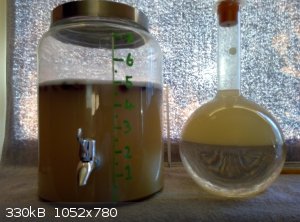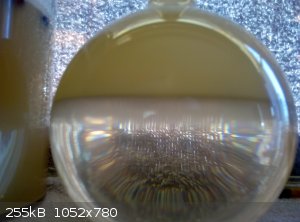Sulaiman
International Hazard
    
Posts: 3558
Registered: 8-2-2015
Location: 3rd rock from the sun
Member Is Online
|
|
how slow is diffusion in liquids ?
Background: I have started another batch of EtOH as feedstock for distillation experiments,
The main batch is on the left, 1kg unrefined sugar, 50g rasins, 20g yeast nutrient, 2g GV4 yeast, originally 5.6l total.

The brown colour is from the cane sugar.
I intend to add more sugar (refined sucrose) in stages as it is consumed by fermentation,
so I put 1 kg sucrose in a 2l flask, with boiled tap water to dissolve it at room temperature, 1.4 litres total volume,
I then topped off the 2l flask with liquid from the now 1-day fermented batch.
The dense saturated sucrose solution at the bottom and the fermenting layer at the top formed two well defined layers.
I expected the two water-based layers to diffuse into each other,
and the high sugar concentration would stop the yeast working.
After one day the layers are quite distinct but with the top c1cm of the lower layer showing signs of diffusion, but not a lot,
and a thin darker layer at the bottom of the top layer. (sediment ?)
The upper layer is still bubbling away, quite vigorously.

The upper 'fermentation' layer being separated from the lower 'feedstock' solution means that the yeast is not exposed to high sugar levels.
This may be a method of achieving maximum ABV.
As I only want the sugar in the 2l flask to add to the main batch
I shall not be persuing this possibility,
but I mention it in case any frequent brewers may want to investigate.
Question : Why have the two layers not diffused into each other ?
even gentle 'swirling' of the flask caused no observable change.
[Edited on 2-1-2017 by Sulaiman]
CAUTION : Hobby Chemist, not Professional or even Amateur
|
|
|
Tsjerk
International Hazard
    
Posts: 3022
Registered: 20-4-2005
Location: Netherlands
Member Is Offline
Mood: Mood
|
|
As fast as the molecules diffusing.
Edit; Ok, I can see the actual question now, I only saw the question "how slow is diffusion in liquid"
[Edited on 2-1-2017 by Tsjerk]
|
|
|
Fulmen
International Hazard
    
Posts: 1693
Registered: 24-9-2005
Member Is Offline
Mood: Bored
|
|
It can be slow all right. I have collected brine from the bottom of a lake, perhaps 80-100m deep. It's a remnant of the last ice age, a lake of salt
water at the bottom of a fresh water lake. And 10'000 years later it still hasn't disappeared.
We're not banging rocks together here. We know how to put a man back together.
|
|
|
Sulaiman
International Hazard
    
Posts: 3558
Registered: 8-2-2015
Location: 3rd rock from the sun
Member Is Online
|
|
OK
I shall not wait for results then 
How and why did you take the sample, and did you find anything interresting ?
[Edited on 2-1-2017 by Sulaiman]
CAUTION : Hobby Chemist, not Professional or even Amateur
|
|
|
careysub
International Hazard
    
Posts: 1339
Registered: 4-8-2014
Location: Coastal Sage Scrub Biome
Member Is Offline
Mood: Lowest quantum state
|
|
Quote: Originally posted by Fulmen  | | It can be slow all right. I have collected brine from the bottom of a lake, perhaps 80-100m deep. It's a remnant of the last ice age, a lake of salt
water at the bottom of a fresh water lake. And 10'000 years later it still hasn't disappeared. |
Here is a paper studying the times for diffusion to erase the stratification in five saline lakes, and the calculated effective diffusion coefficient
(ranges from 0.6 to 22 10^-9 m^2 s^-1). The lakes studied had calculated times for 95% removal of the initial salinity difference from 5,060 years to
34,800 years.
And here is a paper on sucrose diffusion specifically that finds diffusion coefficients in ranging from about 10^-9 m^2 s^-1 (very low sucrose
concentration) to 10^-12 (66.6% sucrose by weight) to 10^-17 (for 90% sucrose by weight). This last would be for something like a partially dehydrated
honey with a glassy structure.
So if you dump a layer of sugar into a container, if it makes a very concentrated solution at the bottom it might have a very slow diffusion rate.
Attachment: lno19752050715.pdf (1.7MB)
This file has been downloaded 296 times
Attachment: price2016.pdf (4.3MB)
This file has been downloaded 282 times
About that which we cannot speak, we must remain silent.
-Wittgenstein
Some things can never be spoken
Some things cannot be pronounced
That word does not exist in any language
It will never be uttered by a human mouth
- The Talking Heads
|
|
|
Fulmen
International Hazard
    
Posts: 1693
Registered: 24-9-2005
Member Is Offline
Mood: Bored
|
|
We were out collecting samples from a drinking water reservoir, so we did it simply because it was there and we had the equipment. A dingy, a hand
winch and a standard water sampler is all you need. Pretty amazing to see something like that, few are aware of such phenomenons and even fewer have
seen it with their own eyes.
We're not banging rocks together here. We know how to put a man back together.
|
|
|
Sulaiman
International Hazard
    
Posts: 3558
Registered: 8-2-2015
Location: 3rd rock from the sun
Member Is Online
|
|
careysub, thanks for the links, to be honest - information overload!
I ended up skimming through to the conclusions 
my only excuse is that I have a lazy brain. 
nevertheless very interesting.
I get more of an idea now why Magpie quotes Nicoderm
"The single most important condition for a successful synthesis is good mixing"
(one day I may have enough experience to know it)
I had always assumed, for no reason, that diffusion was much faster than it is ... by many orders of magnitude 
... still learning
Fulmen ... I bet you wish you'd kept samples now (that I mention it)
did you taste the ancient brine ?
CAUTION : Hobby Chemist, not Professional or even Amateur
|
|
|
j_sum1
Administrator
       
Posts: 6221
Registered: 4-10-2014
Location: Unmoved
Member Is Offline
Mood: Organised
|
|
There is a nice little comparative experiment that you can do on this.
Mix up a phenolphthalein solution and separate into two beakers. Drop a Pasteur pipette into each an allow some time for the liquid to become still.
Mix up equal concentrations of KOH and NaOH and add an equal volume of each to the pasteur pipettes. You can watch the diffusion as it happens
spreading from the tip of the pipettes. And of course the KOH is slower.
|
|
|
AJKOER
Radically Dubious
    
Posts: 3026
Registered: 7-5-2011
Member Is Offline
Mood: No Mood
|
|
I would try placing your compounds in thick clear glass and allowing direct solar light exposure.
Basically, a passive approach to adding energy to the system.
The thick glass is to limit harmful effects of light and still may not work for the likes of fermentation experiments.
|
|
|
Sulaiman
International Hazard
    
Posts: 3558
Registered: 8-2-2015
Location: 3rd rock from the sun
Member Is Online
|
|
I have to experiment in my bedroom at the moment, so with the added heat of fermentation,
keeping the temperature below 25 C (a target that I set based on minimal research) sometimes needs intervention.
(turning off the heat and opening the window 
I deliberately shaded the fermentation - just because I thought sunlight might be 'bad' (I don't know)
I assume that it is just for thermal input, not photo-chemical ?
I am only fermenting for chemistry purposes, I hope to get enough EtOH from this batch to learn the art of distilling.
After that I will probably dry the azeotrope
(of course I can get it to azeotropic .. nearly/maybe, with the wind behind me).
I don't drink now so fermentations will be few and far between
but I used to consider myself quite good at home made wines
elderberry, and gooseberry were my favourites.
P.S. sugar-wash to EtOH is really cheap chemistry 
[Edited on 3-1-2017 by Sulaiman]
CAUTION : Hobby Chemist, not Professional or even Amateur
|
|
|
Fulmen
International Hazard
    
Posts: 1693
Registered: 24-9-2005
Member Is Offline
Mood: Bored
|
|
Sulamain: Smelling it was more than enough. Not exactly tap water quality...
We're not banging rocks together here. We know how to put a man back together.
|
|
|